



IMPROVING LIGHTING AND OPERATION FOR THE NEW BACHMANN PETER WITT CAR
By Charles Long
The HO scale Bachmann Peter Witt car was released in late 2007. Based on a Baltimore prototype, the car was made available undecorated and in Baltimore, Brooklyn, Chicago, Saint Louis & Los Angeles colors. The prototype car, 6119, resides at the Baltimore Streetcar Museum (BSM). It comes with the capability of both DC and DCC operation as well as installed lighting. All of the lighting is via small surface mount yellow LED's. However a few things puzzled me. Operating with DCC using the supplied plug-in decoder, function 0 turns all of the lighting on and off, function 1 dims all of the lights including the interior. Furthermore, the center mounted rear taillight comes on in reverse and operates as a rear headlight. The rear tail marker lights mounted on the letterboard are dummies. Checking with John Engleman at BSM, he informed me that on car 6119 the headlight does not have a dimming function and is on a circuit with the destination sign and can be separately controlled from the interior lights. In addition the rear marker lights are battery powered and the center rear taillight displays "STOP" in red and is activated when there is pressure in the brake cylinder to stop the car.
On several of my models I use Panasonic "Designer Series" red LED's (Digikey Part No. P547-ND, ten for $3.50) that have a 2 millimeter rounded lens that can be cut, filed and/or turned to fit various applications for red tail and marker lights. The Baltimore cars had a railroad style lantern that showed a red lens to both the rear and the side. I had painted an undecorated model of the Bachmann Peter Witt to model the proposed but never acquired Philadelphia 9000 series. These were to be based on the Brill Baltimore design but were never built due to PRT's bankruptcy in the 1930's. I simplified the rear markers to a pair of bull's eye markers similar to the single bull's eye markers installed on the earlier PRT cars. I drilled out the square marker mounting holes for the dummy markers on the letterboard with a #52 drill (the undecorated has these railroad style markers as parts on a separate sprue to be installed by the modeler, the painted versions have them already installed) and used a file and then a piece of 3/32 inch tubing with shallow saw kerfs in the end to act as cutters in a drill to turn down the LED lenses to fit. A small portion of the upper car body was cut away to allow the LED body to fit. After the LED's are secured with epoxy I used black paint to stop any stray red light from shining inside the car.
 |
 |
 |
 |
| Figure 1 - Panasonic 2.0mm LEDs | Figure 2 - 3/32" tubing used as a die | Figure 3 - LED lens being turned down | Figure 4 - Cuts in car body |
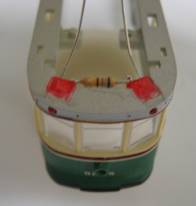 |
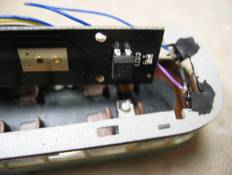 |
 |
| Figure 5 - LEDs installed with 680 ohm resistor | Figure 6 - Opto-isolator installed on underside of PC Board | Figure 7 - Completed Wiring" |
Although the Panasonic LED could be used for the center rear stop light, I was intrigued by the plastic light pipe arrangement used by Bachmann to channel light from the surface mounted LED on the circuit board. I obtained some surface mounted red LED's (Digikey Part No. 160-1181-1-ND, ten for 83 cents) and tried my luck at replacing the factory installed amber rear LED with red. After temporarily removing the clear plastic light pipe I was successful. This is delicate, tricky soldering but most traction modelers should have the skills from working on overhead wire. The polarity must be correct, the LED should light when positive voltage is applied to L+ and negative voltage is applied to L2. It is best to apply DC voltage to L+ and L2- and touch the LED to the pads to verify that it lights and is correctly oriented before soldering.
To operate the rear red stop light I developed a simple circuit using a LTV-8141, AC input, Darlington output opto-isolator (Digikey Part No. 160-1356-5-ND, ten for $4.74) and two resistors. This monitors the voltage fed to the motor and shuts off the rear stop light LED when the voltage rises above 2.5 to 3.0 volts. The AC input allows it to work both forward and reverse, the Darlington circuit drives the LED directly and the isolator function keeps the motor circuit separate from the lighting circuits.
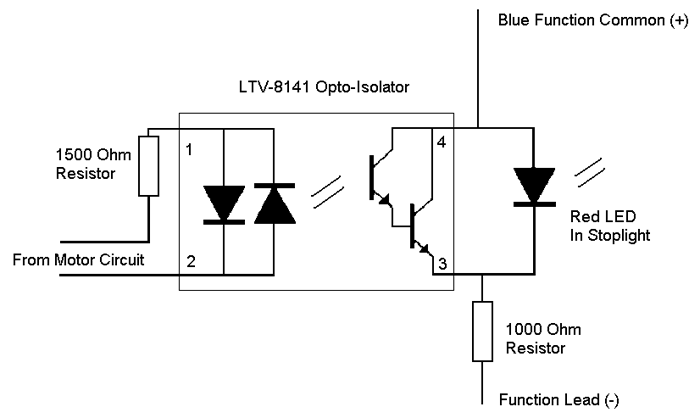
Fig 8. Schematic of Stop Light Circuit
While the Bachmann model includes a DCC decoder, it is a basic one with minimal functionality. I substituted a Lenz Gold Series uninterruptible signal processing decoder with the optional Power-1 module that acts as an electronic flywheel.
The Bachmann printed circuit board has two coils (L1, L2) and two capacitors (C3, C4) that filter the motor circuit to meet some of the European regulations. Reports are that they may cause problems with DCC and I removed them. I also removed diodes D1 through D5 that provide correct polarity to the lighting LED's when used with standard DC. I then drilled four holes (#59 drill) in the rear of the board to mount the opto-isolator. Center it to clear the interior lighting LED-3 and the body mounting ears. The opto-isolator is mounted upside down hanging from the ceiling. The decoder wires are connected as follows to the header pins of the 8-position plug that connects with the socket from the lower floor printed circuit board:
Black to L
Gray to M-
Blue to L+ and then extended to pin 4 of the opto-isolator and the rear marker LED circuit.
Separate wire (I used yellow) from L2 - to pin 3 of the opto-isolator, which is then connected to a 1000 ohm resistor with the other end of the resistor connected to the yellow decoder wire.
White to L1-
Orange to M+
Since I use overhead wire power and want all wheels grounded, the Red decoder wire is soldered to the spring that connects to the trolley pole. To complete the wiring the green decoder lead is connected to pin 3 of the NMRA 8 pin socket, which is otherwise not used. The purple decoder lead is connected to the rear marker light circuit. Pin 1 of the opto-isolator is connected to the front terminal of the removed L1 with a 1500 ohm resistor and pin 2 of the opto-isolator is connected to the rear terminal of the removed L2. I used these two terminals as convenient points to connect to the motor circuit.
To ground all of the wheels. a jumper wire is placed from left to right at the front solder pads of the side bolster contacts on the lower circuit board. Refer to lesson 6-7 (Room 6, lesson 7) in the Trolleyville Schoolhouse for more details on this item.
While the LED's are great for markers and interior lights I still prefer to use incandescent bulbs for streetcar headlights to get the proper appearance. Bulbs rated at 1.5 volts develop little heat. I used a 1.5 volt, 30mA, 1.2mm clear bulb from Miniatronics along with a 390 ohm resistor to replace the front headlight LED and light pipe. Remove LED1, the surface mount resistor (R5) and the capacitor on the lower circuit board. I drilled a #55 hole through the floor centered from the headlight into the currently unused speaker cavity and used the speaker cavity for the 390 ohm resistor. The rear terminals of the removed surface mount resistor and capacitor were used for the lamp leads with the 390 ohm resistor in series with one lead.
The following configuration variable programming changes were made to the Lenz default settings:
CV-3 to 2 to minimize starting delay.
CV-4 to 2 to
minimize braking delay.
CV-33
& 34 to 8 to assign Function 0 for headlight control either forward or
reverse.
CV-35 to 64 to
assign Function 1 for rear marker light control.
CV-36 to 16 to
assign Function 2 for stop light control.
CV-39 to 4 to
assign Function 5 for interior light control.
CV-57 to 0 for
no dimming function.
CV-112 to 200
to increase duration of motor time out when track signal has stopped.
Please understand that all of the changes listed above are unauthorized modifications to the model that will probably invalidate the warranty. The Trolleyville Schoolhouse and the author cannot and will not take responsibility for any models that get ruined in this process. Also, I wish to express my thanks to Bob Dietrich, also of the East Penn Traction Club, for a methodology to improve the turning radius (also described in Lesson 6-7 in the Trolleyville Schoolhouse). This method allowed the car to operate on my layout which has curves modeled on the PRT standard for city intersections, which spirals to a minimum radius of 33 scale feet.

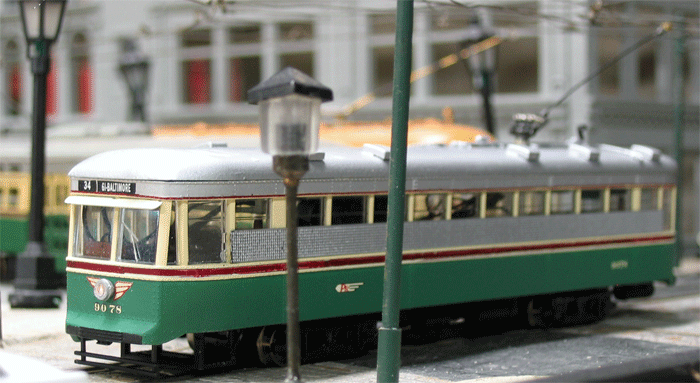
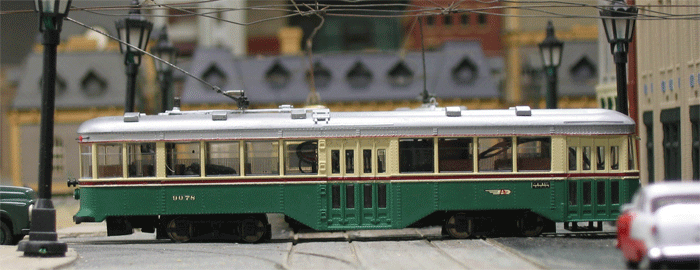
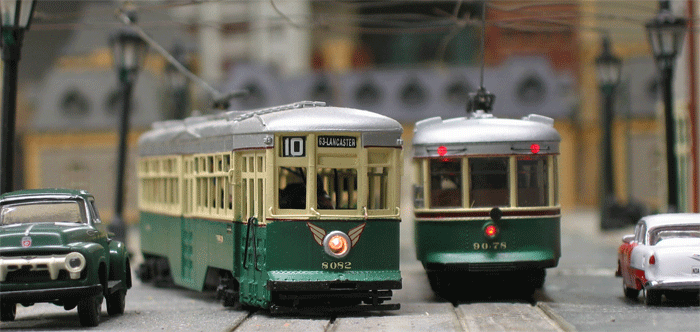
Figs 9-10-11-12, Complete Model decorated with Custom Traxx decals.
Although I firmly believe that the electronic flywheel action of the Lenz Gold series decoders and associated Power-I modules is worth the additional expenditure and the additional lighting functionality is a bonus, I understand that many may want to retain the original Bachmann decoders. In this case, I feel that a more simplified modification could be done. This would be retaining the yellow LED headlight, changing the rear light to a red LED and installing the opto-isolator circuit. While I added two rear marker lights at the letterboard using the existing mounting holes, they could be filled in and a single marker using the Panasonic LED with a 1000-1500 ohm resistor added. Furthermore, I believe the white and yellow function wires can be paralleled so that all lights will be controlled by function 0 and will remain on when the car is reversed.
| Parts List Summary | Digikey No. |
| LTV-8141 Opto-isolator | 160-1356-5-ND |
| Red Surface Mount LED | 160-1181-1-ND |
| Panasonic 2MM Red LED | P547-ND |
| 1500 Ohm Resistor | 1.5KQBK-ND |
| 1000 Ohm Resistor | 1.0KQBK-ND |
| 680 Ohm Resistor | 680QBK-ND |
| 390 Ohm Resistor | 390H-ND |
2-15-2008